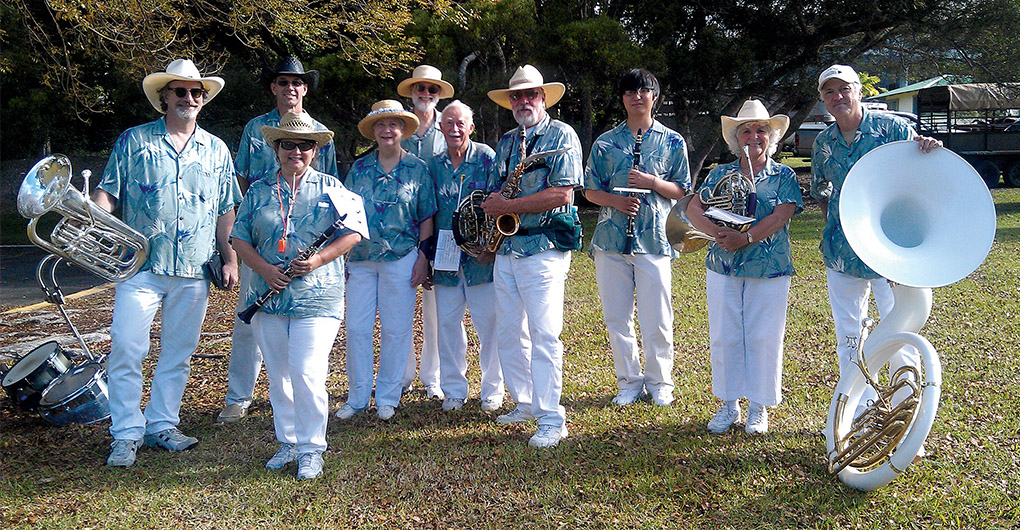An Amazing Thing Is the Humble Gourd: Ipu and the Rediscovery of an Art Medium
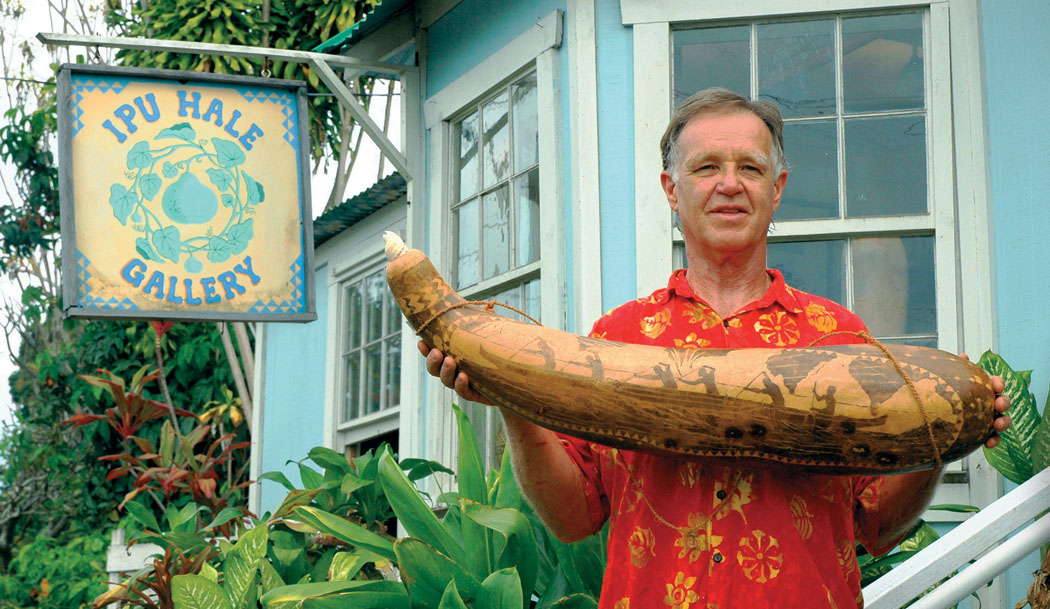
By Fern Gavelek
With no pottery, metal or glass, early Hawaiians found a myriad of creative ways to use gourds. From water carriers to ossuary urns, from musical instruments to canoe bailers, they could be plucked from a vine in the garden—and decorated to please the eye.
The Hawaiian dictionary notes nearly 70 entries for “ipu,” which is the Hawaiian word for the “bottle gourd,” the “general name for vessel or container,” or the “single-gourd” drum. One entry, “Ipu-o-Lono,” describes how gourds were used to honor the gods. Kahiko hula performances are most-oftened accompanied by the beat of an ipu or ipu heke (larger instrument constructed with the joining of two gourds).
Early explorers to Hawai‘i remarked in their journals on the multiple uses of these hard-skinned gourds, or ipu. A total of 36 different uses were described by Ernest Dodge in Hawaiian and Other Polynesian Gourds—12 as either wet or dry containers, used for carrying water and fermenting poi, for example. Five different uses as musical instruments were noted and the rest for other varied uses such as fishing lures, funnels and masks. Ethnologists believe the gourd was the most common container used by all levels of Hawaiian society.
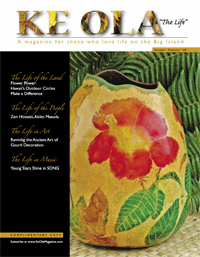
While gourds were especially prized in Hawai‘i for their usefulness, these multi-purpose implements, like pottery, were also decorated. The Rev. William Ellis and others described decorating methods they observed, but over time, the exact techniques were said to have been lost.
That is until Bruce Ka‘imiloa Chrisman M.D., a Midwest native, became fascinated with Hawaiian cultural arts after coming to the islands in the late 1960s. His fascination led to extensive research and the rediscovery of native decorating techniques. Recognized for bringing this technique to light, he has spawned a revival of gourd art.
“My goal was to find out how Hawaiians did this unique art,” notes Chrisman. “It took me 15 years and it’s remarkable that only Hawai‘i developed this decorating style.” The technique is referred to as the Ni‘ihau method, as some scholars believe it originated there.
Michael Harburg, owner of Ipu Hale Gallery in Holualoa, met Dr. Chrisman in 1997 at an ipu decorating demonstration at Honaunau’s Place of Refuge. He learned the basics and got into gourd decorating as a hobby before mastering the art form. While Harburg says the “source is traditional,” he has applied his own artistic style to gourds as an art medium.
“Gourds were the first domesticated plants by humans,” states Harburg, a former mushroom farmer who was attracted to the idea of decorating plant forms. He grows his own gourds. “With a gourd, you were growing a canteen and the canteen enabled travel and transformed the world.”
Harburg believes Ipu Hale Gallery is the only shop of its kind dedicated to the promotion and perpetuation of gourd art. The gallery offers more than 100 gourds created by Harburg and his co-proprietor, Bill Wright. Some have traditional, geometric designs while others depict whales and other island themes.
While gourds have been used and decorated throughout the world, Dr. Chrisman says Hawaiians refined their gourd growing to produce a thin, hard-skinned fruit and decorated their ipu unlike any other culture, dying them from the inside-out. His research found, in essence, that Hawaiians cut their gourd from the vine and then scratched a design into the outer skin, using a sharp object. In a couple weeks, the gourd’s shell sealed beneath the injury, forming a kind of scar as the skin healed. The gourd top was opened, some of the seed and pulp removed, and the gourd was filled with a natural dye. The dye was left to leach through the shell and stain the unscratched area. The sealed, scratched area prevented the dye from coloring the pattern. Then the dye was poured out, the outer skin cleaned off and the gourd left to dry.
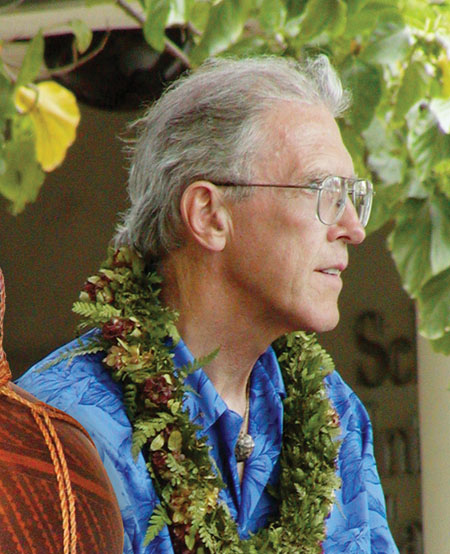
Hawaiians also decorated gourds occasionally by burning a design on the surface, which is a common technique in other societies; the English term is pyrogravure. “It doesn’t hold up nearly as well as Hawai‘i’s unique dying method, unless the burned designs are protected from light,” he explains. “Conversely, light tends to darken dyed gourds over time and natural gourds as well.”
It takes a year to start from a seed to produce a decorated gourd using the Ni‘ihau method, according to Chrisman. “It’s a rarity to do it in the old way,” he adds.
There are several rare souls on Big Island, however, who have taken on the challenge. Along with Harburg, Momi Greene of Keahole-Kona is one of Chrisman’s students who are dedicated to doing it the old way. She studied under Chrisman in the early ‘90s, one of a dozen students chosen from around the Big Island to first experiment in growing seeds and then decorating gourds.
“Bruce gave each of us about 40 seeds and we learned how to discern if a seed is from Hawai‘i or elsewhere,” she explains. “We learned the basics about growing and then applied it to our different environments.” The seeds were for the long, slender ‘olo gourd, the long-necked wai (water) gourd and the ‘umeke (bowl) gourd.
“By going through the tedious process of growing the gourd, I learned of its value,” emphasizes Greene, who works on a plumeria farm with her family. “It’s like having a baby. When it came to gourd decorating, Greene says the students were given “generalized” instructions. “We were told to take a green gourd, incise the design somehow, dye it and dry it out—little details on what to use or how to do it,” she recalls.
Chrisman agrees adding, “That’s the way ancient kupuna taught their students. I tell my students 90 percent of what I know as I want them to seek the rest. Maybe they’ll discover things I didn’t find.”
Dr. Chrisman, a retired surgical dermatologist who now lives in Arizona, first consulted with botanists and then built 33 stone terraces in Honolulu, typical of ancient gardens. Tending to his plants, which opened their blossoms at dusk, he devised cotton and paper coverings to protect his gourds from fruit flies, which arrived in Hawai‘i in the mid-1940s.
He learned through experimental archeology—the replication of recovered artifacts or known activities. “I like challenges and once I knew about the tools and studied old Hawaiian specimens at the museum, I learned by a trial-and-error approach,” and says “I found answers by doing it, such as how Hawaiians cut off the top of a gourd without a hacksaw.”
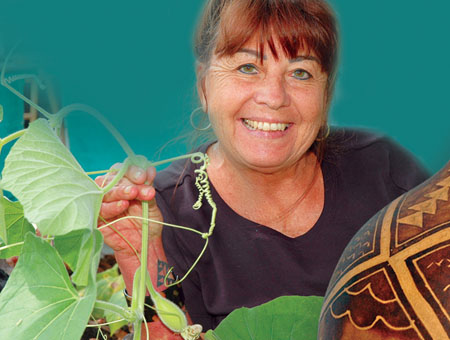
At first, Greene tried different tools to create her designs—shells, shark teeth, a metal Exacto knife—and experimented dying her gourds from the outside and the inside. She made dyes using different plants, finding aloe yielded a golden brown, kukui bark a reddish brown and ulei a pinkish brown.
“The other students experimented with decorating too, some even baked their gourds, and so our gourds all looked alike, but were different,” she said.
Today, Greene has honed her tools and techniques of choice and has figured out how to best grow gourds in Keahole, using fruit fly bait. After scratching her design on the gourd, she makes a hole to get the pulp and seeds out from the inside. For the long-necked wai gourd, this is especially difficult.
“I take my gourds down to the beach and use sand, tiny pebbles and sea water to clean the insides,” she shares. “I fill and empty many, many times. While doing this process, Greene, who is part Hawaiian, feels connected to her past. “I know this was done before, probably here at this beach.”
Greene’s designs use patterns that repeat themselves and are already in Hawaiian culture, such as geometric shapes, stars, the sun and birds. “The triangle stands for the hala tree,” she details. “My grandparents used the hala design in lei making and I feel connected to them through that shape.”
According to Chrisman, Hawaiian geometric design is referred to as pawehe. The Pukui-Elbert Hawaiian Dictionary defines it as “generic name for colored geometric motifs, as on Makaloa mats made on Ni‘ihau, bowls and gourds.”
After beginning with the traditional designs, and over time and gained expertise, Harburg began creating contemporary designs, and now sells gourds which depict turtles, hibiscus and mangoes in his gallery. The Colorado native also developed a method for using synthetic, fiber-reactive dyes to give his designs vivid colors like red, yellow, green and most recently, blue.
“Using color is tricky because the gourd is organic and draws dye to the surface by capillary action,” explains the Holualoa artisan. “It’s similar to dying a white carnation in colored water. You’re using living tissue and have to be attune to the life cycle of that tissue.”
Still, Harburg points out that knowledge of this art is a gift from old Hawai‘i and as such, he feels obligated to pass on the tradition to others by teaching at various venues, such as the Amy B. Greenwell Ethnobotancial Garden in Captain Cook. He also serves as a cultural demonstrator at Hawai‘i Island’s national parks, creating gourds reminiscent of museum specimens, using old patterns and native dyes.
Greene doesn’t sell her green gourds, emphasizing the importance of growing your own. Prices for her decorated gourds range from $50 to $500 and they can be found at community art fairs and at events staging Hawaiian cultural activities.
While Chrisman has sold some of his gourds, he points out that he doesn’t make them for commercial gain, but buyers can reach him at imiloapacific@earthlink.net.
With gourds being so important to mankind, it seems only fitting to decorate and cherish them. ❖
The 2010 Ipu Cultural Festival January 23-24 at Hale Halawai in Kailua-Kona. For details on the fourth annual event,visit www.hawaiigourdsociety.com or email outtayourgourd@gmail.com.


